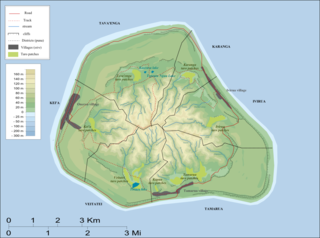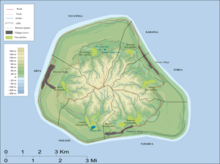
Penrhyn is an atoll in the northern group of the Cook Islands in the south Pacific Ocean. The northernmost island in the group, it is located at 1,365 km (848 mi) north-north-east of the capital island of Rarotonga, 9 degrees south of the equator. Its nearest neighbours are Rakahanga and Manihiki, approximately 350 kilometres (220 mi) to the southwest. Once one of the most heavily populated atolls, it was almost completely depopulated by Peruvian slavers in 1864.

The traditional music of Tuvalu consists of dances, including fatele, fakanau and fakaseasea. The influence of the Samoan missionaries sent to Tuvalu by the London Missionary Society from the 1860s resulted in the suppression of songs about the traditional religions or magic and many songs were lost. As the influence of the missionaries diminished in the 20th century the traditional dances were revived and the siva dance tradition from Samoa also became popular. The fatele, in its modern form, is performed at community events and to celebrate leaders and other prominent individuals.

Mangaia is the most southerly of the Cook Islands and the second largest, after Rarotonga. It is a roughly circular island, with an area of 51.8 square kilometres (20.0 sq mi), 203 kilometres (126 mi) from Rarotonga. Originally heavily populated, Mangaia's population has dropped by 75% in the last 50 years, mainly due to the decline of the pineapple industry in the 1980s and a subsequent economic crisis in 1996.

Mitiʻāro, the fourth island in the Cook Islands group, is of volcanic origin. Standing in water 14,750 feet (4,500 m) deep it is four miles (6.4 km) across at its widest point.
Rakahanga-Manihiki is a Tahitic language belonging to the Polynesian language family, spoken by about 2500 people on Rakahanga and Manihiki Islands and another 2500 in other countries, mostly New Zealand and Australia. Wurm and Hattori consider Rakahanga-Manihiki as a distinct language with "limited intelligibility with Rarotongan". According to the New Zealand Maori anthropologist Te Rangi Hīroa who spent a few days on Rakahanga in the years 1920, "the language is a pleasing dialect and has closer affinities with [New Zealand] Maori than with the dialects of Tongareva, Tahiti, and the Cook Islands"

Karanga is the smallest of the six traditional districts of the island of Mangaia, in the Cook Islands archipelago. Karanga is located in the northeast of the island, to the east of the District of Tava'enga and northwest of the District of Ivirua. The district was traditionally divided into 5 tapere:
- Kaau-i-uta
- Kaau-i-miri
- Teia-pini
- Teia-poto
- Teia-roa

Kei'a is one of the six traditional districts of the island of Mangaia, which is part of the Cook Islands archipelago. It is located on the west side of the island, to the south of the District of Tava'enga and west of Veitatei. The district was traditionally divided into 6 tapere:
- Akaoro
- Tapuata
- Tongamarama
- Te-inati
- Rupetau-i-miri
- Rupetau-i-uta

Veitatei is one of the six traditional districts of the island of Mangaia in the Cook Islands. It is located in the south of the island, to the east of the District of Kei'a and west of the District of Tamarua. The district was traditionally divided into 6 tapere:
- Te-noki
- Te-tuaroa (Te-tukono)
- Te-tuapoto
- Te-tarapiki
- Kaikatu
- Angarino

Tamarua is one of the six traditional districts of the island of Mangaia, which is part of the Cook Islands archipelago. Tamarua is located in the southeast of Mangaia, to the south of the District of Ivirua and east of the District of Veitatei. The district was traditionally divided into 9 tapere:
- Maru-kore
- Poutoa-i-uta
- Poutoa-i-miri
- Akaea
- Te-vai-kao
- Angauru (Autaki)
- Vaitangi (Pukuotoi)
- Te-vai-taeta-i-uta
- Te-vai-taeta-i-tai

Ivirua is one of the six traditional districts of the island of Mangaia in the Cook Islands in the South Pacific Ocean. It is located in the east of the island, to the southeast of the District of Karanga and north of the District of Tamarua. The district was traditionally divided into 6 tapere:
- Te-pauru-o-Rongo
- Te-korokoro
- Te-uturei
- Te-ara-nui-o-Toi
- Te-i'i-maru
- Avarari
Ngatiarua is one of four traditional districts on the island of Mauke in the Cook islands. It is in the north of the island, between the districts of Makatea and Vaimutu, and is subdivided into five or six tapere.

I-57, later I-157, was an Imperial Japanese Navy Kaidai-class cruiser submarine commissioned in 1929. During World War II, she supported Japanese forces during the invasion of Malaya in December 1941, the Dutch East Indies campaign in early 1942, and the Battle of Midway in June 1942. She then served on training duties — except for a brief period of participation in the Aleutian Islands campaign in 1943 — until she was converted into a kaiten manned suicide attack torpedo carrier in 1945. She surrendered to the Allies at the end of the war in 1945 and was scuttled in 1946.

Pokerekere Islet, also known as Pokerere or Tautua, is an islet in Penrhyn Atoll (Tongareva) in the Cook Islands. It is located on the eastern edge of the atoll, between Kavea and Tuirai.

Mangarongaro is an islet in Penrhyn Atoll (Tongareva) in the Cook Islands, in the South Pacific Ocean. Mangarongaro makes up most of the southwestern rim of the atoll, south of Moananui Islet and west of Atiati. The islet was once inhabited, and contains the remains of two marae, Rakahanga and Te Vete.

Atutahi is an islet in Penrhyn Atoll (Tongareva) in the Cook Islands, in the South Pacific Ocean. It is on the southern edge of the atoll, between Moturakina and Ahu a Miria. The island contains both a marae, Te Rupe-tangi-rekareka, and a stone ellipse.

Tepuka is an islet in Penrhyn Atoll (Tongareva) in the Cook Islands. It is on the south-eastern edge of the atoll, between Ahu a Miria and Patanga. The island was once inhabited, and contains the remains of two marae, Te Puka-nui and Punaruku. The latter was the site of a village and missionary church, abandoned after the island was almost completely depopulated by Peruvian slavers.

Kavea is an islet in Penrhyn Atoll (Tongareva) in the Cook Islands, in the South Pacific Ocean. It is on the eastern edge of the atoll, between Temata and Pokerekere Islet. Kavea was once inhabited and contains a marae, Mahora-kura.

Veseru is an islet in Penrhyn Atoll (Tongareva) in the Cook Islands. It is on the eastern edge of the atoll, between Tuirai and Takuua. The island was once inhabited and contains a marae, Arahura,

Ruahara is an islet in Penrhyn Atoll (Tongareva) in the Cook Islands, in the South Pacific Ocean. Ruahara is on the northern edge of the atoll, between Takuua and Painko. The island was once inhabited and contains two marae, Te Tohi and Sivalau.







